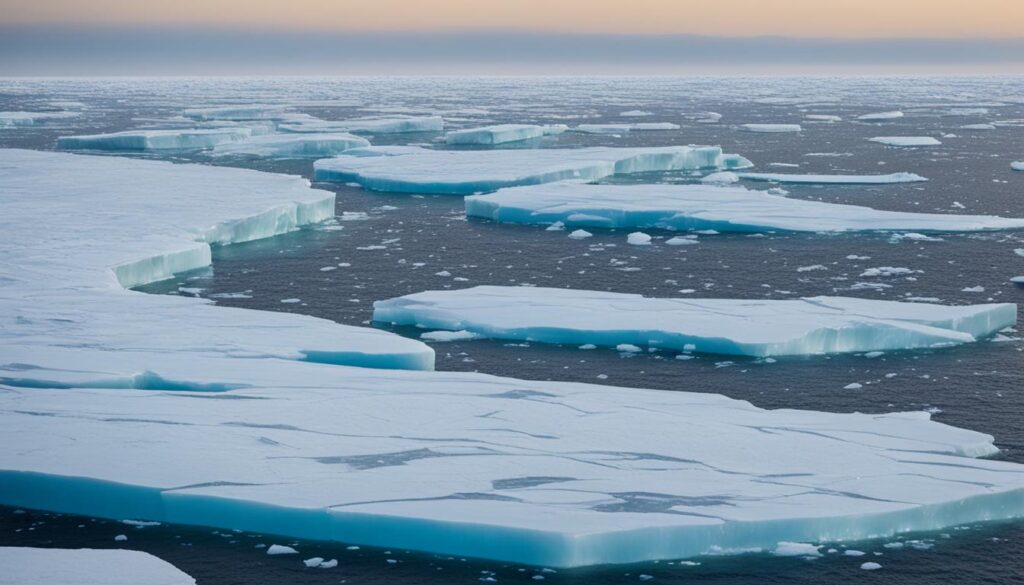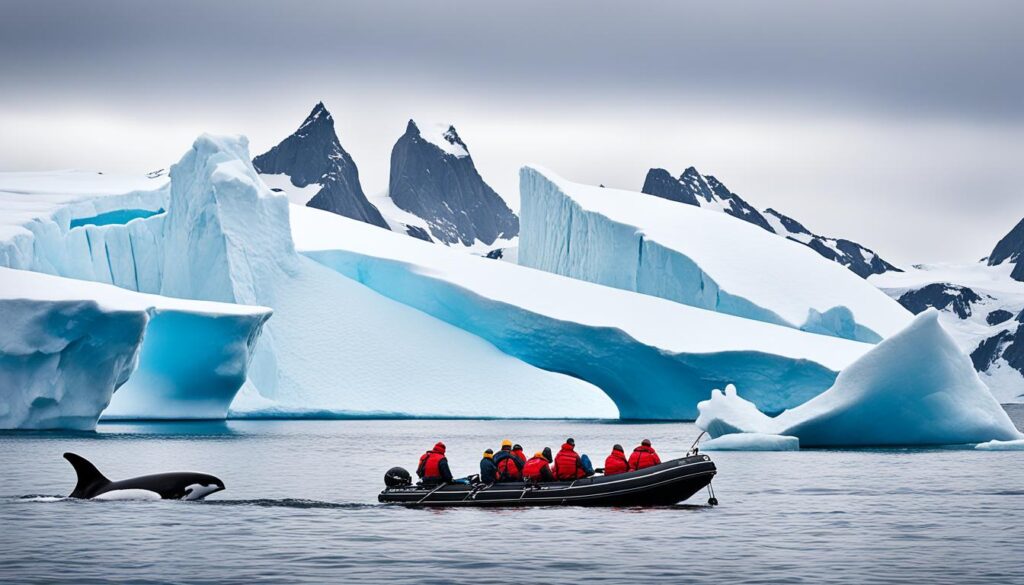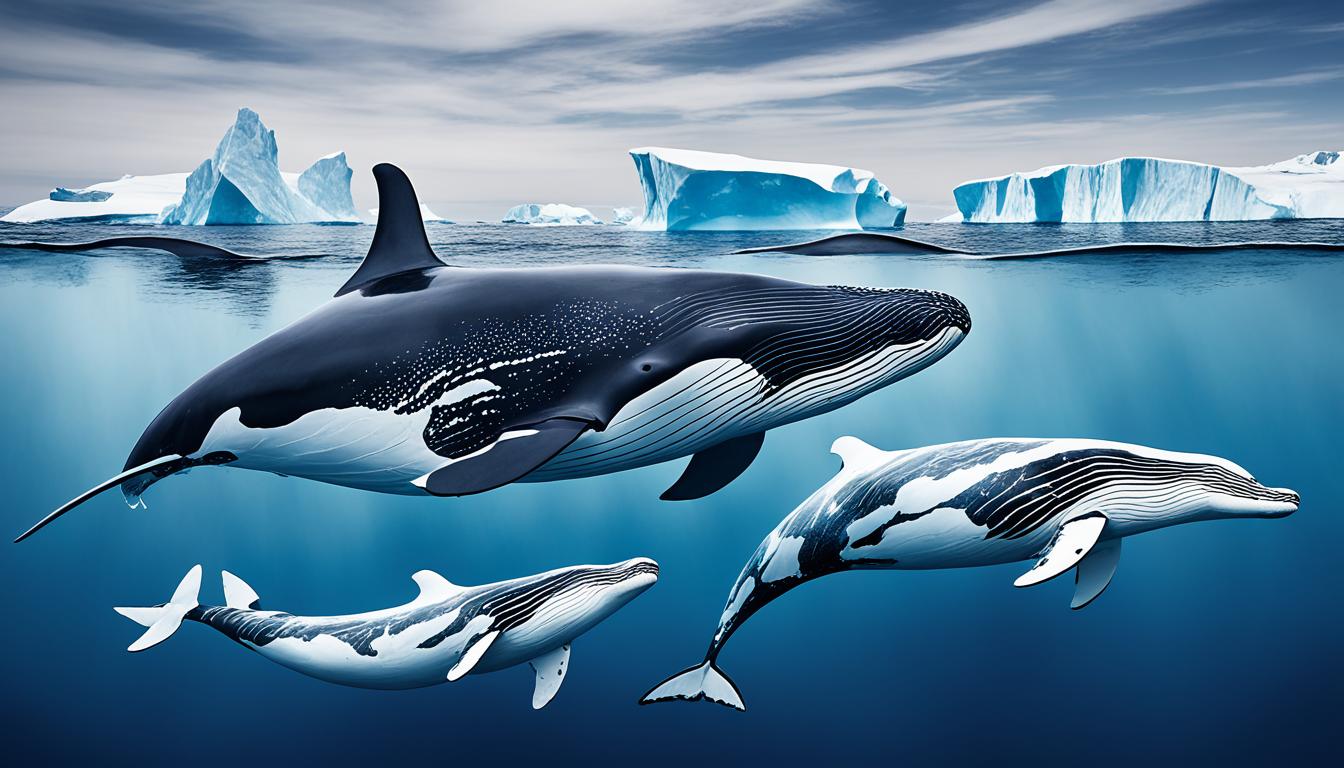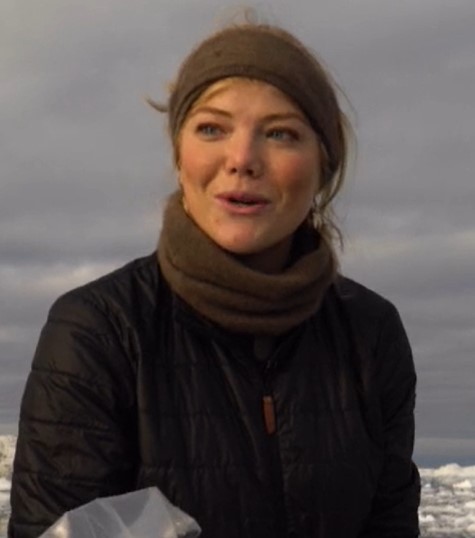The Antarctic region is facing a big challenge – climate change. As temperatures rise, the balance of the Antarctic ecosystem is changing. This puts the future of its famous whales at risk1.
The Antarctic Peninsula has seen a huge 3°C increase in air temperature, much faster than the rest of the world1. The west coast has also seen a 1°C rise in ocean temperatures over 50 years1. These changes are causing ice shelves to melt1, with 25,000 km2 lost since the 1950s1. They’re also making Antarctic krill, a key food source, decline1.
Key Takeaways
- The Antarctic region is experiencing rapid warming, with the Antarctic Peninsula warming at 5 times the global average.
- The retreat of ice shelves and decline of Antarctic krill, a key food source, threaten the ecosystem and the whales that depend on it.
- Climate change-driven changes in the Southern Ocean are affecting the entire Antarctic food web, from krill to whales.
- Protecting Antarctic whales and their habitat is crucial for maintaining the delicate balance of the Antarctic ecosystem.
- Understanding the impacts of climate change on Antarctic whales is a critical scientific priority.
The Threat of Climate Change to Whales
Climate change is a big threat to whales because they need specific places to live and feed. They also migrate long distances2. A humpback whale can weigh up to 40 tonnes and eats about three million Antarctic krill every day2. But, the changing climate is a big danger to these huge sea creatures.
Whales’ Vulnerability to Climate Change
Ocean temperatures in West Antarctica have gone up by more than 2.7°C since the 1970s3. This has made the home of Antarctic krill, a key food for whales, move south by up to 440 km3. This change is a big worry because krill are very important in the Antarctic ecosystem2.
Early Warnings from Scientists
Scientists have been warning about the dangers to whales for a long time2. In 2023, there was less Antarctic sea ice than usual, and it has been getting less since 20173. Southern right whales are now 20% thinner because they don’t have enough food due to climate change3.
Researchers are studying krill to help protect whales that depend on them23. There are rules to limit how much krill fishermen can catch to protect whales23. But, the climate crisis is still a big threat to these amazing animals23.
“There are rational grounds for expecting serious adverse impacts on whale populations due to climate change.”
– Malcolm MacGarvin and a researcher, 1990s
Antarctic Krill: A Vital Food Source Under Threat
The Importance of Antarctic Krill
Antarctic krill are key to the Southern Ocean’s ecosystem. They feed many whales and other sea creatures4. These small shrimp-like creatures are a big part of the ocean’s life, helping to feed a wide range of marine animals5. They also help remove 23 to 39 million metric tons of carbon dioxide from the air each year, playing a big role in the ocean’s carbon cycle6.
Climate Change and Declining Sea Ice
Climate change threatens the future of Antarctic krill4. Krill live in cold, rich waters and need the sea ice to survive. But as the ice melts, krill are in danger6. If the ocean warms up, krill could lose 40% of their mass by 2100, affecting their growth and how many babies they have6.
Krill eat algae that grows under the sea ice. If krill numbers go down, it could harm the Antarctic ecosystem and the whales that rely on them for food4. Scientists think that fewer humpback whales are having babies because there’s less krill for them to eat4.
| Year | Krill Catch (metric tons) |
|---|---|
| 2007 | 104,728 |
| 2022 | 415,508 |
The krill fishery has grown a lot, from 104,728 metric tons in 2007 to 415,508 metric tons in 20224. This increase is because of the growing demand for krill oil and feed additives. But it raises concerns about managing krill sustainably and avoiding overfishing6.
“Antarctic krill are the most abundant multicellular wild animals, with their biomass estimated to range between 300 million and 500 million metric tons.”
As climate change affects the Antarctic, the future of krill and the whales that need them is uncertain. Protecting these vital food sources and the Southern Ocean will need a joint effort from many groups.
Studying Whales in the Antarctic Peninsula
Researchers are using new methods to study Antarctic whales and their home in the ocean. They’re focusing on a special crossbow to get skin and blubber samples from these huge animals7.
These samples are very important. They help us understand the whales’ health, what they eat, and if they’re pregnant. This info shows how climate change might affect their numbers7.
Collecting Whale Samples with a Crossbow
The team has made a special crossbow for whale sampling. It’s designed to take samples when whales come up for air. This way, scientists can learn about the whales without disturbing them8.
Aerial Observations with Drones
They’re also using drones to watch the whales from above. Drones help them see how the whales eat, live together, and move. This gives them a better view of these amazing sea creatures8.
By mixing data from the crossbow and drones, the team gets a full picture of the whales and their world. This helps them understand how climate change affects these incredible animals78.
“The combination of close-range sampling and aerial observations allows the research team to gather comprehensive data on the whales and their environment.”
This new way of studying Antarctic whales is key to understanding their link with the changing climate. It helps with conservation efforts and keeps the Antarctic ecosystem balanced78.
antarctic whales and climate change
Tracking Whale Health and Pregnancy Rates
Scientists are keeping a close eye on Antarctic whales to see how climate change affects them. They study the chemical makeup of whale skin and blubber. This helps them understand the whales’ health and how well they can reproduce.
They’ve found some worrying signs. For example, Type B2 killer whales are much skinnier than Type A and B1 whales9. This means they might not be doing well in their environment, and their numbers could drop.
From 2016 to 2019, Type A and B1 whales were bigger than before9. But, the health and pregnancy rates of these whales are still a big concern. Scientists are trying to figure out how climate change, food availability, and whale health are linked.
To understand how whales react to climate change, researchers use drones to take thousands of photos of the Antarctic Peninsula9. This helps them watch the whales’ numbers, where they eat, and other important things. This info helps with conservation efforts.
As the climate keeps changing, it’s vital to keep Antarctic whales healthy and strong. The studies help us understand how to protect these amazing creatures10.
Whales and the Ocean’s Carbon Cycle
Whales are key players in the ocean’s carbon cycle, fighting climate change as natural allies. They act as “ecosystem engineers” by fertilizing the ocean with nutrients from their feces. This helps phytoplankton grow, which absorbs and stores carbon11. Whales also store carbon for a long time, both during their lives and after they die and sink to the ocean floor11.
The Role of Whales in Carbon Sequestration
Scientists stress the need to protect whales for their ecosystem services. Their conservation helps keep ocean ecosystems healthy and fights climate change11. If whale populations were to recover from past overhunting, it could lower greenhouse gas levels in the air11. The IMF says that if whales were at their pre-whaling numbers, they could boost phytoplankton growth. This would capture more CO2 each year11.
The fishing industry has added over 730 million tons of carbon dioxide to the atmosphere since 1950, as much as 188 coal-fired power plants in a year11. Yet, whales’ role in the ocean’s carbon cycle is gaining attention. Researchers see whale conservation as a way to fight climate change11.
“Supporting efforts to restore whale populations could aid in the battle against climate change.”
Climate change, pollution, fishing, and ship collisions threaten whales11. Protecting these marine giants lets them sequester more carbon and help the ocean become healthier and more resilient11.
Krill Fisheries and Protection Zones
Climate change is causing a decline in Antarctic krill. This threatens not just whales but also the Antarctic krill fisheries in the area12. Krill are crucial for 96% of the calories of certain seabirds and mammals in Antarctica12. Warming waters are making it harder for krill to grow and live in the Southern Ocean. By the end of this century, krill might lose 30% of their home12. Acidification could lead to the collapse of krill by 230012.
Balancing Krill Harvesting and Whale Conservation
Groups like the WWF want to create marine protected areas to limit krill harvesting in key whale feeding spots12. The CCAMLR has agreed to update krill fishery rules to think about predator needs12. This balance aims to keep the krill fishery sustainable while protecting whales’ food sources12.
As climate change affects Antarctica, working together is key. Scientists, policymakers, and industry must develop management strategies that protect whales and their food12. The SCAR Krill Expert Group is working to better understand Antarctic krill12. The ARK started voluntary actions in 2018 to help penguins during breeding season13.
| Key Findings | Impact |
|---|---|
| Krill biomass has been declining since the mid-1970s, shifting towards higher latitudes near the Antarctic Peninsula since the late 1990s12. | The Southern Ocean ecosystem heavily relies on krill as a keystone species, impacting the biological carbon pump and nutrient cycles12. |
| A new generation of fisheries using pumping systems to collect krill effectively year-round poses a challenge to the ecosystem12. | In 2021-22 season, at least three whale deaths occurred due to accidental kills by krill fishing vessels13. |
| Industry data indicates a significant increase in international interest in krill fishing, particularly for use in aquaculture feed, pet foods, and omega-3 supplements13. | Research highlighted a significant reduction in Antarctic krill numbers in recent years, primarily attributed to climate change, leading to increased stress on wildlife that rely on krill as a food source13. |

“Less-available krill might be responsible for significant decreases in chinstrap penguin populations across the Antarctic Peninsula.”13
The Antarctic krill fisheries and whale conservation efforts face big challenges. Creating marine protected areas and working together on sustainable resource management is key to protecting the Antarctic ecosystem1213.
Whale Poop: A Valuable Scientific Resource
In the remote Antarctic waters, whale poop is a goldmine for scientists14. It’s packed with iron, 10 million times more than seawater14. This “liquid, smelly gold” helps us understand whales’ diets, health, and hormones.
By studying whale feces, scientists learn how climate change affects whales14. For example, sperm whales help remove 200,000 metric tons of carbon from the air each year14. That’s like taking 70,000 cars off the road. Blue whales eat 40 million krill daily, which is like 8,000 pounds14.
Collecting these samples is tough, but it’s key for whale conservation14. Krill numbers have dropped by over 80% since the 1970s, affecting whales and the environment14. Knowing about whales’ health and diet is crucial for their future.
Whales play a big part in the ocean’s carbon cycle15. They help produce the air we breathe, thanks to their poop and phytoplankton15. Some whales are as heavy as 150,000 lbs, feeding phytoplankton that absorb CO2 and turn it into energy15. Billions of tons of carbon go from the air to the ocean floor yearly, thanks to phytoplankton and whales15.
Phytoplankton and the ocean are key in fighting climate change15. Whale poop supports these plankton, which are vital for marine life and the environment15.
| Whale Poop and Carbon Sequestration | Value |
|---|---|
| Iron in whale poop compared to seawater | 10 million times higher14 |
| Carbon removed by sperm whales in Southern Ocean per year | 200,000 metric tons14 |
| Krill consumed by blue whales per day | 40 million, equivalent to 8,000 lbs14 |
| Decline in Antarctic krill populations since 1970s | More than 80%14 |
| Carbon transferred to ocean bottom annually by biological pump | Billions of metric tons15 |
| Oxygen produced by phytoplankton | More than 50% of the world’s oxygen15 |
Whale poop is a vital scientific resource16. Sperm whales in the Southern Ocean add 50 tonnes of iron to the sea each year16. This helps remove 400,000 tonnes of carbon, twice as much as their breathing16. Industrial whaling cut the sperm whale population, reducing CO2 removal16. With the IWC reviewing whaling rules, protecting whales is more crucial than ever.
The Impact of Antarctic Tourism
Antarctica has always drawn adventurous travelers, leading to a big increase in tourism. From 6,704 visitors in 1992-93, tourism has grown to 104,897 in 2022-2317. This growth shows how popular it has become.
Tourist ships help scientists with research, but they also affect the environment and Antarctic whales. Studies show that tourists change penguin behavior, impacting wildlife17.
The Antarctic Treaty System and The Madrid Protocol set rules for Antarctica. But, the tourism industry mainly manages itself, following IAATO’s guidelines17. Many worry that this self-regulation might not protect Antarctica’s wildlife and ecosystems17.
As tourism grows and changes, its negative effects on the environment could get worse, especially with climate change17. The Antarctic Peninsula has warmed by over 5°F since 1970, causing some penguin colonies to disappear18.
Tourism adds to threats like climate change and invasive species in Antarctica17. The Southern Ocean has taken in a lot of excess heat and carbon dioxide, and melting ice shelves could raise sea levels by several feet by 210018.
We need to manage tourism in Antarctica with science and best practices to lessen its harm17. Keeping an eye on tourism’s effects is key to seeing if new rules work and to improve them17. Researchers should look at more than just visitor numbers to understand tourism’s full impact17. More research is needed to guide policies on sustainable tourism in Antarctica17.

“The Antarctic Treaty System, including The Madrid Protocol, regulates all activities in Antarctica. However, day-to-day management of tourism is primarily self-regulated by the industry through guidance issued by the International Association of Antarctica Tour Operators (IAATO).”
Conclusion
The study of Antarctic whales and their reaction to climate change shows how important they are for the Antarctic ecosystem’s health. Antarctic whales, like blue whales and humpback whales, tell us about changes in the Southern Ocean19. As climate change affects their food and homes, saving these whales is key for their survival and the ocean’s health.
Scientists learn a lot by studying whales’ health and how they interact with their world. This knowledge helps us make better conservation efforts and policies to protect these important animals19. Whales help keep the ocean healthy by controlling prey and nutrients, which supports carbon sequestration19.
The future of Antarctic whales is tied to our planet’s future, making their protection a global issue19. By saving these amazing creatures and managing their homes and food wisely, we help keep the Antarctic ecosystem strong. This benefits the whole ocean and our planet.
FAQ
What is the threat of climate change to Antarctic whales?
What is the importance of Antarctic krill for whales?
How are researchers studying the impacts of climate change on Antarctic whales?
How do whales contribute to the ocean’s carbon cycle?
How are researchers and conservation organizations working to protect Antarctic whales and their food sources?
How is whale poop being used in scientific research on climate change impacts?
What are the challenges and opportunities of Antarctic tourism for whale conservation?
Source Links
- Impacts of climate change – Discovering Antarctica
- Following Antarctic whales for climate change clues
- Climate change — WWF Protecting Whales & Dolphins Initiative
- From Antarctica to Tasmania, the debate over whether to fish a creature the size of a paper clip is key to saving the climate—and the humpback whales
- Antarctic krill: Superheroes of the Southern Ocean
- Climate change and overfishing threaten once ‘endless’ Antarctic krill
- Conservation work soars to help whales – WWF-Australia | Conservation work soars to help whales | WWF Australia
- Meet the fearless scientists saving Antarctic whales… With crossbows and tiny inflatable boats
- How Rapid Warming Affects Some Killer Whale Populations off the Antarctic Peninsula
- ‘Save the Whales’ was a shining success. Now can humpbacks save us from ourselves? | CNN
- To fight climate change, save the whales, some scientists say
- Krill Experts Discuss Need to Protect Southern Ocean’s Keystone Species
- Scientists: Fishing boats compete with whales and penguins for Antarctic krill
- The Poop Loop — Parley
- whale poop and phytoplankton, fighting climate change | IFAW
- Faecal attraction: Whale poop fights climate change
- Impacts of tourism in Antarctica
- Climate Crisis in Antarctica – Antarctic and Southern Ocean Coalition
- Antarctic whales for climate change clues

